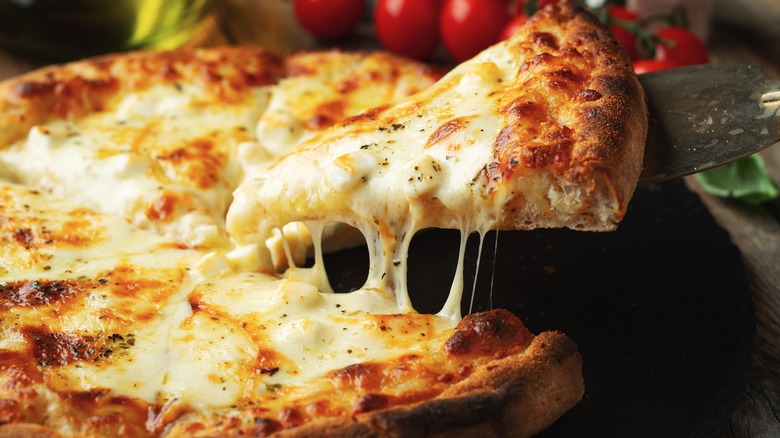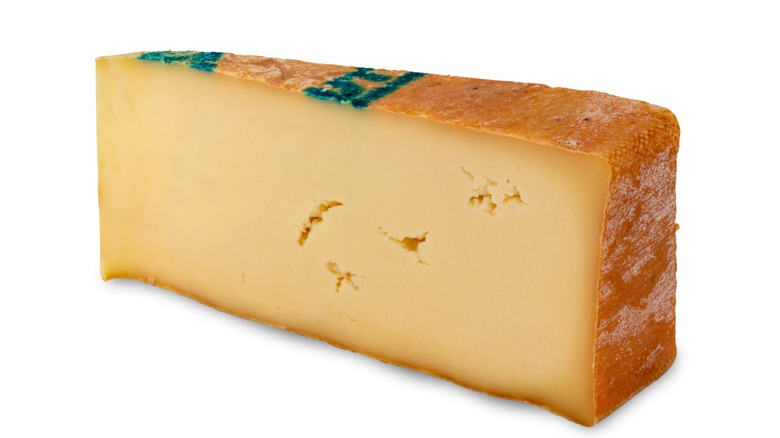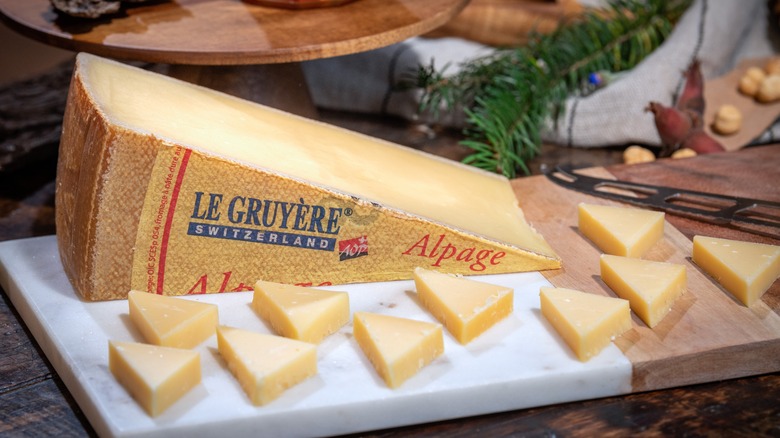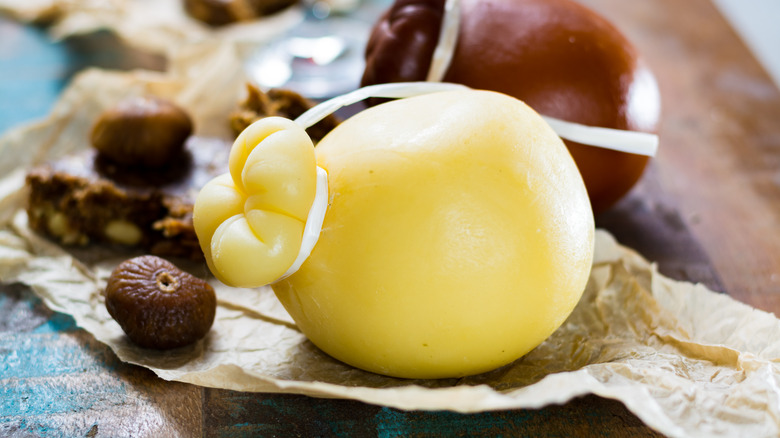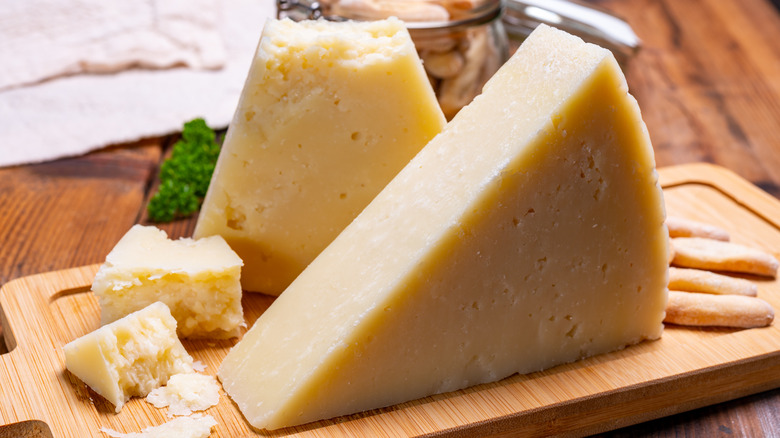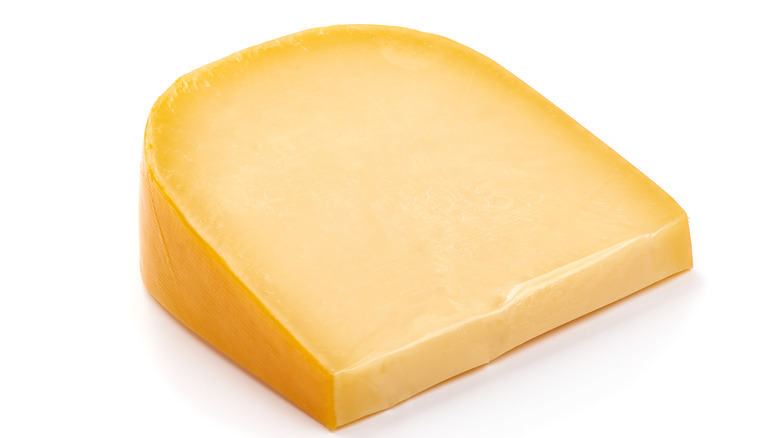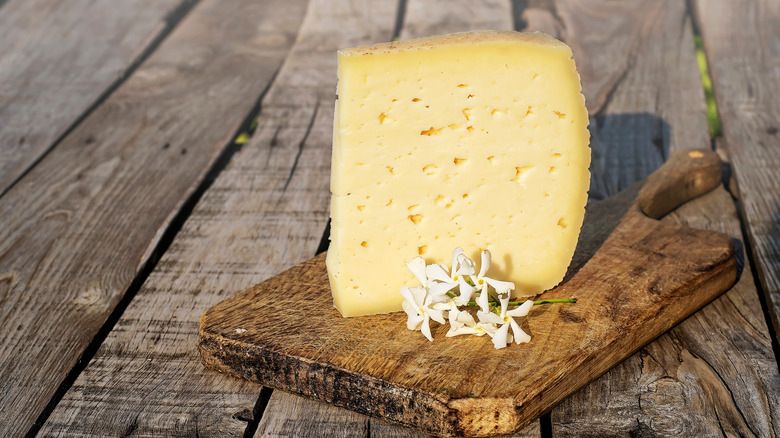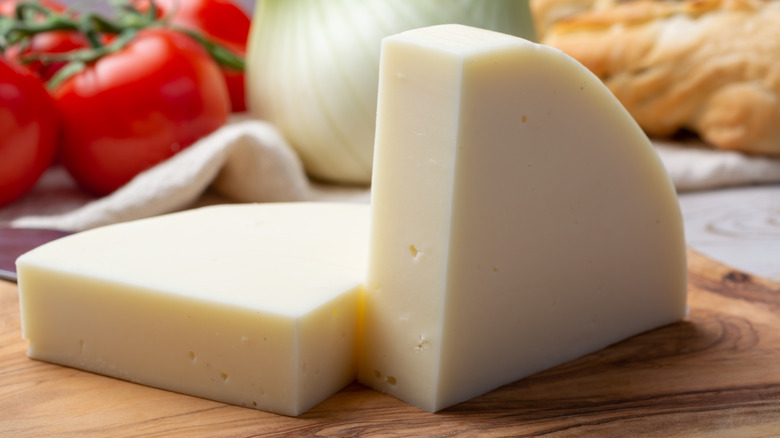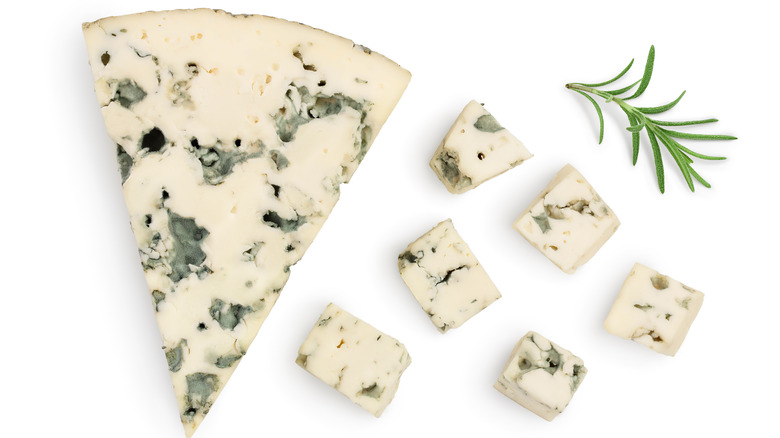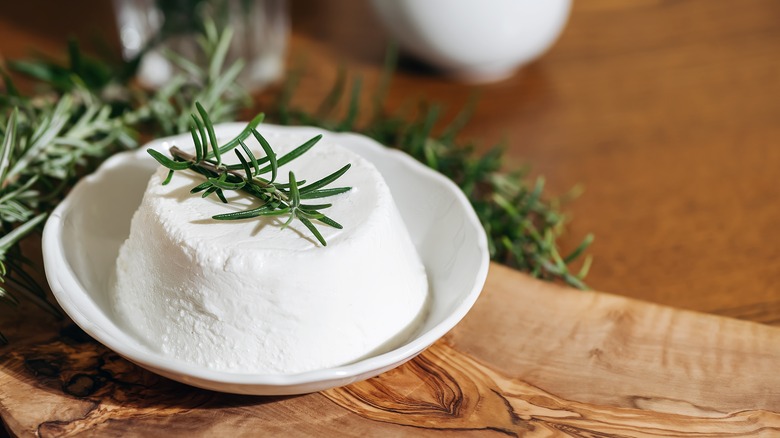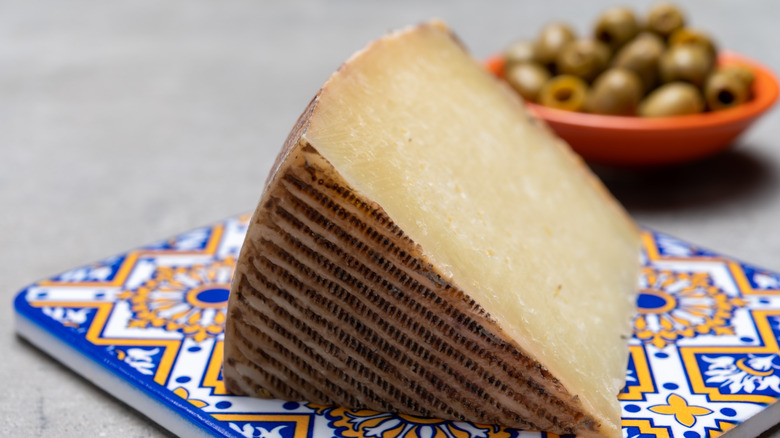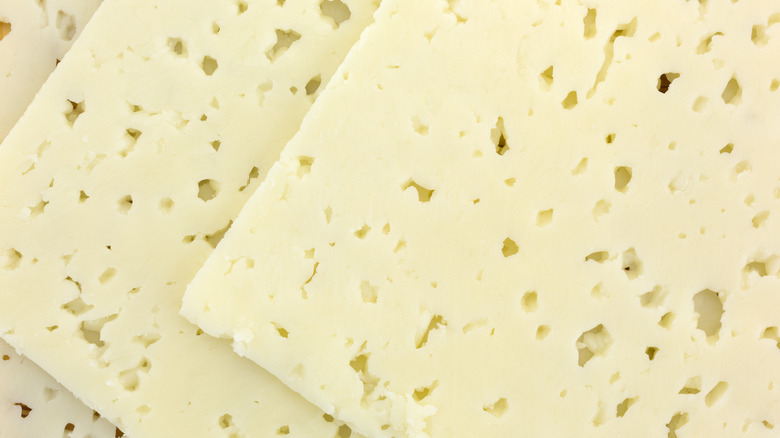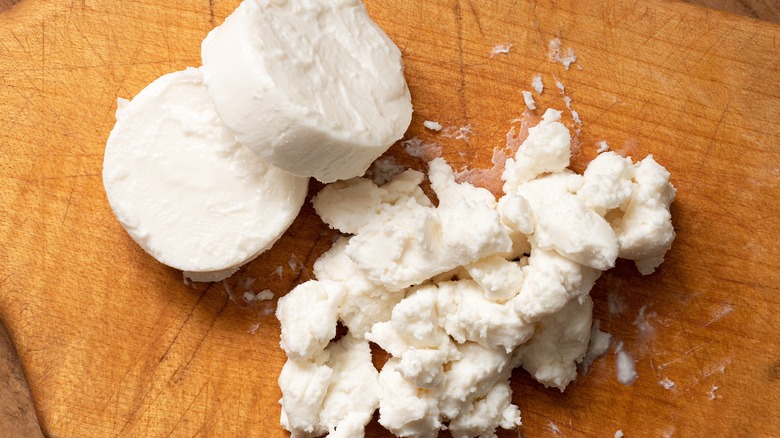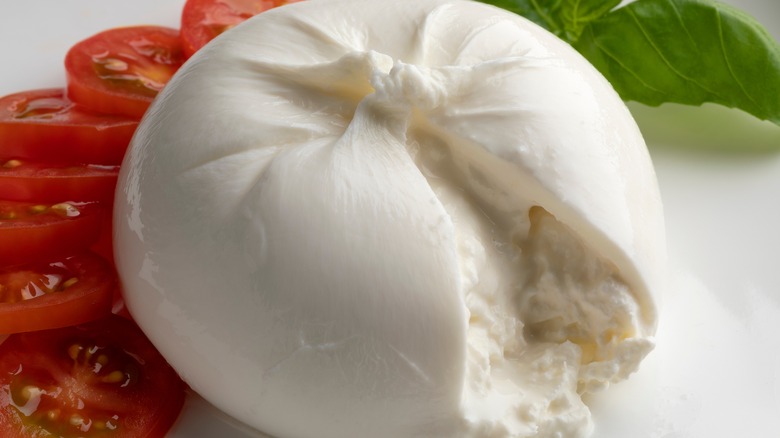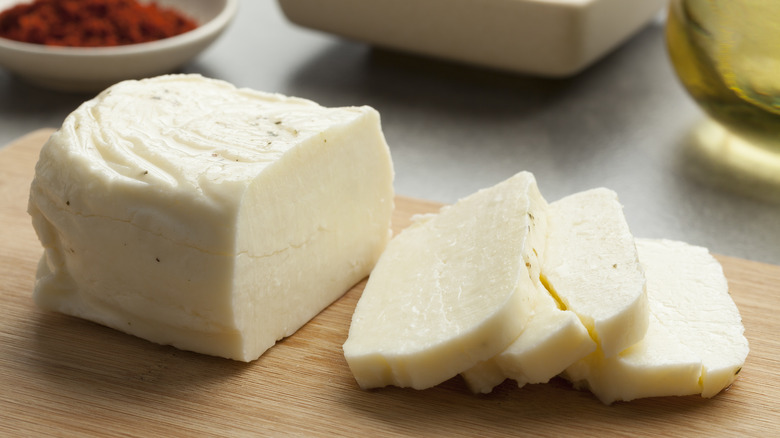14 Underrated Cheeses You Need To Try On Pizza
Pizza is a popular food, and it's easy to understand why. It's the perfect mix of tangy tomato sauce, gooey cheese, and crispy crust. Pizza is an art form, and pizza crust is a blank canvas that pizza lovers can decorate with their favorite toppings. And there's no topping more essential than the buildable base of a delicious sprinkling or heaping pile of cheese.
Mozzarella cheese may be the most common way to top a pizza given how low-moisture mozzarella melts smoothly and holds all of your favorite toppings in place. But mozzarella isn't the only cheese in town.
Even if you've branched out from basic mozzarella to try fresh mozzarella, Parmesan, or even cheddar, you may still be selling your tastebuds short. There are many other amazing kinds of cheese that add something special to this beloved food. If you consider yourself a pizza lover, you owe it to yourself to try a far-ranging variety of cheese on your pies. So hit the store (or the local pizzeria) and pick up a pie featuring one of these underrated types of cheese.
1. Fontina
Fontina is a natural choice for a mozzarella substitute. It melts well, and you can find it included in other similarly cheesy favorites, like gourmet grilled cheese sandwiches, and classic American cheeseburgers. As such, this mild Italian cheese makes an excellent pizza topping.
Fontina cheese is an Italian cheese with a buttery, nutty flavor. This cheese is made from cow's milk and ranges from semi-soft to semi-hard. While it originated in Valle d'Aosta, Italy, today it's produced in many countries and is easy to find in supermarkets.
You can use fontina on its own for a basic cheese pizza or mix it with other cheeses to make a cheese blend. Fontina has a similar texture to mozzarella because they are both made with the same pasta filata process, which is the stretching and pulling of the cheese curds resulting in a similar final product. Because of its mild taste, it works in just about anything that requires gooey cheese. Fontina is an underrated cheese that deserves to be on more pizzas.
2. Gruyère
Top anything with Gruyère cheese and elevate it to a gourmet meal. If you've ever eaten fondue, then you have probably tried Gruyère. This rich cheese made in Switzerland is often the key component of fondue, croque monsieur sandwiches, potatoes au gratin, and quiche lorraine. It is made in the French-speaking region of the Swiss Alps, where they have been making this rich melting cheese since the 12th century. To this day it's made with unpasteurized cow's milk, following the original traditions. Gruyère has an official status and must be made the same way in the same region to bear the name and seal of Gruyère.
While Gruyère is a Swiss cheese, it isn't the Swiss cheese from your favorite deli ham sandwich. Instead, Gruyère has a higher fat content than its cousin with all the holes. If you are ready to indulge in a decadent pizza experience, replace your mozzarella with Gruyère, and you won't be sorry.
Unfortunately, this delightful creamy cheese can be hard on your wallet. Since it is only produced in one region, it can be expensive. And that rich taste is also rich in fat and calories. You may only want to add Gruyère to your pizza when you're looking for a fancy pizza for a special occasion.
3. Caciocavallo
Pizza lovers who are new to this tasty Sicilian cheese are in for a treat. Caciocavallo is an air-dried cheese similar to mozzarella and made with the same stretching method, but with a much deeper taste. This cheese with the teardrop shape has a sharp, intense, almost spicy flavor that can take a pizza to another level. The name caciocavallo translates to "cheese on horseback" because when it is cured, two pieces of cheese are tied together and hung over a board. It's this curing method that also creates the cheese's unique teardrop shape.
Caciocavallo works just as well as part of a charcuterie board as it does melted on a pizza. Due to its strong flavor, it works well mixed in a cheese blend or as the only cheese on the pizza. The more caciocavallo is aged, the saltier it becomes, so adding it to a pizza with complementary toppings like arugula or roasted vegetables creates a nice balance.
While caciocavallo is a popular cheese for its rich flavor, you may have to head to your local cheesemonger or international market to find it. But don't worry, the trip will be worth the extra effort thanks to the richness this cheese brings to a basic pizza pie.
4. Pecorino
Pecorino cheese is a favorite Italian export. Pecorino cheese is made from sheep's milk and comes in varying forms from region to region. Pecorino Toscano has a mild earthy flavor and comes from Tuscany. Pecorino Siciliano has a mild flavor and more texture thanks to the addition of pistachios or peppercorns and is a common table cheese in Sicily. And Pecorino Sardo from the island of Sardinia has a mild sweetness to it and can be eaten on its own or mixed in other dishes. But the most popular and common variety is Pecorino Romano.
Pecorino Romano is an all-star Italian cheese with a sharp taste and a firm texture, making it perfect for sprinkling on a pizza. This beloved Italian cheese is aged at least three months before it graces the table. It is a key player in four quintessential Italian pasta dishes: cacio e pepe, Amatriciana, carbonara, and gricia.
The best way to use this popular cheese on pizza is by using it alongside other favorite Italian pizza toppings like prosciutto, pancetta, spicy salami, marinated artichokes, and roasted peppers.
5. Gouda
Gouda is a Dutch cheese that can hold its own on an Italian pizza. Gouda is made with cow's milk and has many forms, including young, mature, and aged. Young Gouda, aged around four weeks, tastes mild, while aged Gouda which cures from seven to 12 months, takes on a more intense nutty caramel flavor. The more aged the cheese, the more it develops a texture and grittiness similar to Parmesan Reggiano.
Gouda may also come smoked or infused with herbs and spices. Choosing the right Gouda for your pizza depends on the other toppings you are pairing it with and. Try Gouda on a pizza with other toppings that can balance it out like crisp pear slices and salty pancetta. Or keep things simple with a mushroom pizza with Gouda and shallots. Smoked Gouda pairs well with chorizo and red onions on pizza.
When it comes to Gouda, the possibilities are practically endless.
6. Asiago
Asiago is one of the most underrated cheeses. It is an Italian cheese made with cow's milk and, while quite popular in Italy, doesn't get as much attention in the States as it should. It is kind of a cousin of the infamous Parmigiano Reggiano, which often overshadows Asiago in the culinary world. But Asiago cheese deserves to take center stage because it is an amazingly good cheese and an excellent addition to pizza.
Asiago cheese is a semi-soft cheese with a creamy, buttery flavor due to its higher moisture levels, particularly present in younger cures of the dairy product. This increased moisture content helps make the cheese good for melting which is exactly why it's a good option on pizza. Aged versions of Asiago have more depth of flavor with a sharp tang that separate it from Parmesano Reggiano. Aged Asiago loses some of the moisture associated with the younger versions of the cheese, becoming slightly drier. That said, it still melts well into sauces and on top of pizzas.
7. Provolone
If you're looking to try new cheeses on pizza or simply don't have any mozzarella on hand, provolone is the way to go. Provolone cheese is a stretched curd cheese made with cow's milk, similar to mozzarella and caciocavallo, giving it the same general texture and melting ability.
There are two types of provolone: provolone dolce and provolone piccante. The former is aged for a few months and is similar to the provolone slices you've probably tried at a sandwich shop or deli counter. Provolone piccante is aged for longer, giving it a deeper, more intense taste.
Generally speaking, provolone has a light taste and creaminess that works well on practically any pizza, whether you're craving a more classic pepperoni pizza or a supreme veggie-topped pie. Plus, it's a cheese that's affordable and widely available, making it a good option when you want something a little bit different but not too far off the beaten path.
8. Blue cheese
Pungent blue cheese may not be everyone's favorite — its strong smell, colorful hue, and questionable origins can be a put-off. But pairing blue cheese with pizza is not a new idea. Many popular pizzerias offer blue cheese dressing as a pizza dipping sauce.
In the U.S., blue cheese is widely used as a component in salad dressings, and some adventurous diners enjoy it as a tasty nibble straight off the charcuterie board. Blue cheese comes in many forms, but if you are new to using blue cheese, opt for a milder variety like Gorgonzola Dolce or Chiriboga Blue, which aren't as strong as the classic Roquefort.
The best way to use blue cheese is to crumble it right on the pizza. You can start by sprinkling on a layer of mozzarella before adding the blue cheese as one of the toppings rather than the main cheese. It pairs well on pizzas with other intensely-flavored toppings like smoky pancetta, rich caramelized onions, savory strips of steak, or tangy barbeque chicken.
9. Ricotta
Soft ricotta cheese is a staple in Italian dishes, from lasagna to manicotti to cookies. That's right, this cheese works well in both sweet and savory dishes. In Italy, ricotta is sold fresh daily and eaten like yogurt with a spoon. But if you have trouble finding it fresh near you, you can always make ricotta at home — it's a surprisingly simple process.
The best way to use ricotta on pizza is to add dollops to the top of the pie before popping it in the oven. THe cheese holds its form when heated, so it won't become a runny, soggy mess on your pie.
Because ricotta can adapt to both sweet and savory flavor pairings, it's fun to use on pizzas with more unusual toppings. You can make a savory ricotta pizza with spicy sausage, tangy sun-dried tomatoes, and fresh spinach, or try mixing sweet with heat with a ricotta pizza paired with spicy honey, sliced pears, and walnuts.
10. Manchego
Manchego cheese is a traditional cheese hailing from the La Mancha region of Spain. Like some other traditional cheeses, it's made with sheep's milk rather than cow's milk. It's a rich cheese aged between two weeks and two years. Because sheep's milk has double the amount of fat as cow's or goat's milk, Manchego cheese has a rich, buttery consistency that melts nicely on a pizza.
This Spanish cheese pairs well with typical Spanish ingredients like tangy olives, smoky chorizo, or salty anchovies. If you like your pizza to bring the heat, add spicy nduja sausage spread for a Calabrese-style pizza with peppers. The creamy Manchego is a perfect match when the spiciness is off the charts.
When shopping for Manchego you may notice a wide range of prices. This is because true Spanish Manchego only comes from Spain, but Mexican cheesemakers have been making a Manchego with cow's milk for years. The two kinds of cheese are actually very different, despite bearing the same name. The controversy over the shared name has actually made it all the way to government offices and has even held up international trade deals.
If you want a true Spanish Manchego for your pizza, check for the official PDO (Protected Designation of Origin) stamp. It will be more expensive, but quality comes at a higher price point.
11. Havarti
Creamy Havarti cheese is originally from Denmark and is one of the most luscious melt-in-your-mouth cheeses to add to a pizza. Havarti is made with whole cow's milk and has 45% butterfat content. Creamy Havarti, another version of this Danish cheese, has 60% butterfat making them both perfect for melting onto a piping hot pizza pie. Plus, Havarti is high in calcium and protein, so you can feel good about including it in your night of pizza indulgence (via Farmer's Cheese Making).
On its own, Havarti has a sweet, mild flavor that's rich and buttery with a tangy undertone. Apart from traditional Havarti, you can find many variations made with herbs and spices. Whether you select a standard version or something like dill, garlic, or jalapeno Havarti, they all make an excellent addition to pizza. If you like your pizza with extra bite, try a horseradish Havarti with smoky sausage and earthy mushrooms.
12. Goat cheese
Goat cheese may not be the first cheese you think of when looking for new ways to top your pizza, but it definitely makes our list of underrated cheeses to try because it adds such nuance to a pizza's flavor profile.
Goat cheese is unsurprisingly made from goat's milk and is also known as chèvre, which means goat in French. Goat cheese is a soft cheese that comes in spreads, logs, or crumbles. The best way to use it on pizza is to sprinkle crumbles over the top. Goat cheese has a bit of tanginess to it and is best with savory, earthy toppings like caramelized onions, roasted vegetables, or salty prosciutto that can hold up to the strong flavor of goat cheese.
Another reason to add goat cheese to your pizza is that it is considered one of the healthiest cheeses. According to Healthline, goat cheese is easier for the gut to digest and is lower in lactose than other cheeses.
13. Burrata
Have you ever tried putting burrata on a pizza? Burrata is a unique type of cheese made with fresh mozzarella in a manner that's similar to making mozzarella itself. Burrata is made from cheese curd bits and cream stuffed into a mozzarella pouch. These wet curds make up the inside of the gooey burrata called stracciatella. You might need to take a trip to a cheesemonger or international shop to find burrata, but when you do, it's worth it.
Since burrata is already wet, it gets even soggier when melted, so the best way to use it on pizza is to add it to the pizza right after it comes out of the oven as an additional topping. As a fresh cheese, it will keep its flavor best when served at room temperature — not too hot or cold. Burrata cheese pairs well with veggie toppings like sprigs of spicy green arugula, or slices of heirloom tomatoes.
14. Halloumi
Have you tried Greek cheese on an Italian pizza? Halloumi is a Greek cheese traditionally made from goat and sheep's milk. This semi-hard cheese has a high melting point, so it is often grilled or fried, which gives it an even richer taste. You can add slices of halloumi or grated halloumi to your pizza for a salty flavor with a bit of a bite. Since halloumi has a rich history in Mediterranean cuisine, it makes sense to pair it with other Meditareean pizza toppings like marinated artichokes, Kalamata olives, or sun-dried tomatoes.
Aside from a unique flavor and incredible texture, adding halloumi to your pizza has some health benefits. According to Healthline, halloumi cheese is high in protein and calcium, making it a good choice to meet your daily requirements. Unfortunately, that deep salty flavor comes at a price, and halloumi is high in sodium. If you're watching your sodium intake, enjoy halloumi in moderation.
